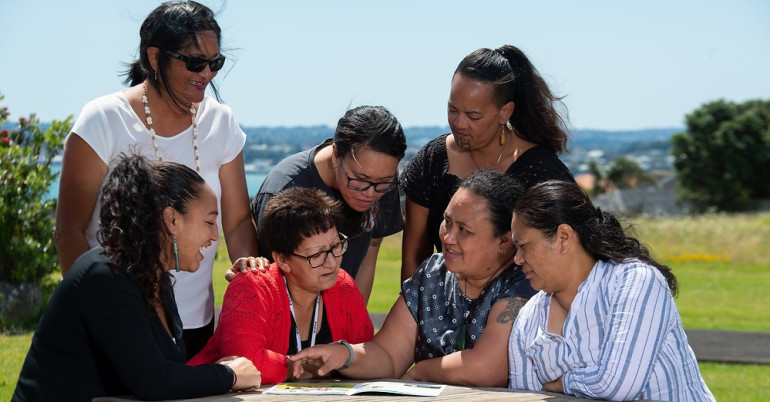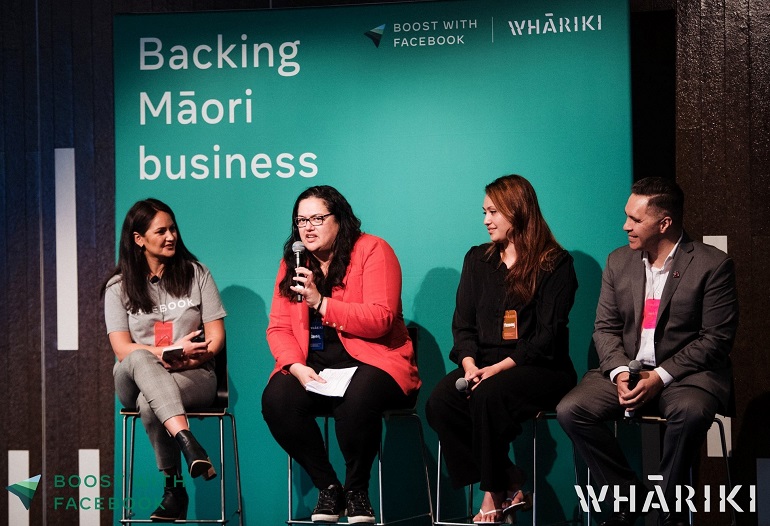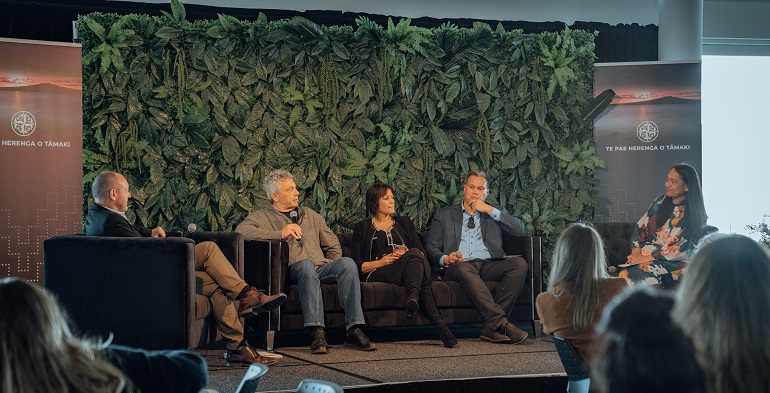Tangata Whenua
Tāmaki Makaurau is home to approximately a quarter of the Māori population of Aotearoa. The majority of Maōri living in the region are urbanised; disconnected from their hapu, iwi and whenua and the identity and strength this provides them.
On this page
Kia whakatōmuri te haere whakamua
I walk backwards into the future with my eyes fixed on my past.

Photo: Ngāti Whātua Ōrākei
The Māori asset base in Tāmaki Makaurau is valued at $12.5 billion, which is slowly diversifying into a broad range of other sectors outside the traditional agriculture, forestry and fishing areas. Māori employers, employees and self-employed people are in more diverse, high-skilled and high wage occupations than Māori in the rest of Aotearoa.
Te Ōhanga Māori, Tāmaki Makaurau Auckland’s Māori Economy [PDF 417 KB](external link)
RSLG approach
A 3-part framework underpins the RSLG’s approach to the needs and aspirations identified by Māori for workforce and employment across Tāmaki Makaurau. This involves mandating Tāmaki 10,000 as the first Māori workforce strategy for the RSLG, ensuring the inclusion of key actions for Māori across the RSLG work plan, and acknowledging that where further Māori workforce strategies may be developed by Māori in the future, these strategies will also be moved to be mandated by the RSLG.
Tāmaki 10,000
Tāmaki 10,000 is the Māori Employment Strategy which provides a blueprint to tap into the historical success of Māori and support the reclamation of Māori ingenuity and innovation. The goal is to see 10,000 whānau in Tāmaki Makaurau supported throughout their employment journeys, whether they are rangatahi entering the workforce, unemployed whānau seeking new opportunities, people in employment looking for a career change, or Māori business owners looking for support to thrive in the changing economic environment.
Tāmaki 10000: Advancing Māori Employment — Report 2020 [PDF 3.07 MB](external link)
Tāmaki 10,000 was developed in partnership with iwi, urban Māori and Māori providers across Tāmaki Makaurau who make up the Te Pae Herenga o Tāmaki (TPHoT) collective. TPHoT is a collective of urban Māori and iwi Whānau Ora organisations driving the charge to support Māori in Tāmaki Makaurau to make aspirational change. In 2020, TPHoT recognised that COVID-19 was amplifying employment and economic disparity for Māori, and hosted Te Pae Heringa Summit to explore solutions to close this growing social and economic divide. From this summit, a steering group was formed and Tāmaki 10,000 was conceived.
Te Pae Herenga o Tāmaki(external link) — Waipareira Trust
The Tāmaki Makaurau RSLG has endorsed Tāmaki 10,000 and there is an agreement in principle that both organisations collaborate on regional relationships. These include funders, employers, education providers, unions and employment and enterprise support networks working together to support the exploration of enterprise, employment and training opportunities. The focus is on seeking new and devolved funding that fosters sustainable and meaningful employment benefiting whānau, the organisations they own and work in, communities and the economy.
Te Mahere Whai Mahi Māori, the Government’s Māori Employment Action Plan, sets out a suite of actions to improve labour market outcomes for Māori, with the vision of “Māori exercising rangatiratanga to create intergenerational wellbeing through work”. The Tāmaki 10,000 Strategy provides a route map for enabling and exceeding this vision. Tāmaki 10,000 is not just about providing a paycheck to whānau, it is about harnessing the innovation and entrepreneurship of the region’s ancestors to create pathways to prosperity – physical, spiritual, mental and economic. It is about building the aspirations of whānau and providing solutions that facilitate ongoing, generational change.
Te mahere whai mahi Māori – Māori Employment Action Plan [PDF 376 KB](external link)
Tāmaki 10,000 seeks to change the way Māori are seen in society, breaking down barriers to success, cutting the chains of colonialism and enabling whānau Māori to have equitable opportunities in enterprise and employment. It is about creating an employment landscape that allows Māori to experience employment success as Māori. Using Tāmaki 10,000, the region can draw on the spirit, knowledge and tikanga of its ancestors to propel change defined by Māori for Māori, and to deliver a pathway to an aspirational future.
Key labour market and workforce insights
- Māori in Tāmaki Makaurau have experienced severe and ongoing economic and social deprivations. COVID-19 has deepened employment and economic disparity for them. Without comprehensive and immediate intervention, the social and economic divide will continue to grow.
- Almost a quarter of Aotearoa Māori live in Tāmaki Makaurau.
- The Māori population of Tāmaki Makaurau is very young (median age is 25 years) and labour force participation is growing faster than non-Māori.
- Māori are over-represented as machinery operators and drivers, labourers and community and personal service workers, and they are under-represented in managerial and professional occupations and have lower educational attainment. Further, there are Māori in the workforce with low numeracy and literacy.
- Career guidance services for Māori are broken and ineffective. There is a need for activities that lead to higher incomes and jobs with genuine career pathways, offering continuous learning and development as the nature of work changes.
- Inequities in pay for Māori deepen socio-economic problems in an already high-cost region.
- Tāmaki Makaurau has the largest regional concentration of Māori businesses, and most of these have experienced financial distress due to economic shock and uncertainty over the past decade and most recently from COVID-19.
- Tāmaki Makaurau has the majority share of Māori employers in professional, scientific and technical services and high value manufacturing. However, these Māori businesses are still unable to access Kānoa regional economic development and investment unit funding which is available to almost every other region.
Tangata Whenua actions
- The RSLG has endorsed Tāmaki 10,000 as a Māori Regional Labour Market Strategy.
- The RSLG will support Tāmaki 10,000 and Whāriki Māori Business Network to work together to explore workforce opportunities for Māori and support outcomes for Māori small to medium enterprise.
- The RSLG will advocate for foundational incentives to be developed for employers and kaimahi Māori as lifelong opportunities to upskill, learn, develop and maintain employability through economic periods of growth and disruption.
- The RSLG will stand by programmes and initiatives that address both pay equity and pay parity for Māori in the workforce and support industry sectors and businesses that promote good pay for the right skills and career development.
Tāmaki 10000: Advancing Māori Employment — Report 2020 [PDF 3.07 MB](external link)
https://www.whariki.co.nz/(external link)
Tautokohia ngā pakihi Māori kia tū rangatira ai
Your business needs to reflect Te Ao Māori in order for it to attain chiefly status.
“There are already over 3000 Māori businesses in Tāmaki Makaurau, across all of the region’s future industries. These Māori-owned enterprises make up 89% of the $12B Tāmaki Māori economy. This presents a significant opportunity for future growth and whanau prosperity. Accelerating and scaling-up Māori-owned enterprises, will be a step change for the Māori economy and workforce.”
Heta Hudson – Chairperson, Whāriki Māori Business Network

Photo: Whāriki Maori Business Network
“Tāmaki 10,000 is to accelerate more Māori into good paying jobs here in Tāmaki Makaurau. Part of the solution here is that we all have to do our bit.”
Rangimarie Hunia – Chief Executive, Ngāti Whātua Ōrākei Maia

Photo: Te Pae Herenga O Tāmaki
“COVID-19 changed the way our whānau worked and shopped. We have seen an explosion of the 'side hustle'… this is evidence of whānau resilience, innovation and adaptability. Māori living within Tāmaki have been forced to re-imagine and re-evaluate their aspirations and Tāmaki 10,000 is another mechanism to support them achieve new levels of employment and learning, take new risks and thrive as Māori in Tāmaki.”
Jacqui Harema – Director Whānau Ora – Te Whānau O Waipareira

